What is Cross-Validation and Validation in Machine Learning?
In machine learning, cross-validation and validation are two important methods for assessing the performance of a model. Cross-validation is a technique for estimating how well a model will generalize to new data. Validation is a technique for assessing the accuracy of a model on a dataset. In this blog post, we will explore the differences between cross-validation and validation. We will also discuss when to use each method and how to implement them in machine learning.
Cross-Validation
Cross-validation is a technique for assessing the accuracy of a machine learning model. It involves partitioning the data into two or more sets, training the model on one set and then testing it on another. This process is repeated until all sets have been used as both training and test sets. The final accuracy score is then calculated by averaging the scores from all the iterations.
There are several benefits to using cross-validation over traditional hold-out validation. First, it reduces the chance of overfitting, as the model is trained and tested on different data each time. Second, it gives a more accurate estimate of model performance, as all of the data is used in both training and testing. Finally, it is more efficient than hold-out validation, as there is no need to reserve a portion of the data for testing.
Cross-validation can be used with any machine learning algorithm, but it is most commonly used with decision trees and neural networks.
Validation
Validation is the process of assessing whether a machine learning model is accurate. This can be done using a variety of methods, but the most common is cross-validation. Cross-validation involves partitioning the data into a training set and a test set, training the model on the training set, and then assessing its accuracy on the test set.
There are a few things to keep in mind when doing validation:
1. The goal is to assess how well the model will generalize to new data, not just how well it fits the training data. This means that it is important to use a test set that is representative of the data that the model will ultimately be used on.
2. It is also important to use a sufficiently large test set. If the test set is too small, there may not be enough data to accurately assess the model’s performance.
3. When partitioning the data into training and test sets, it is important to do so randomly. This ensures that both sets are representative of the overall data distribution and helps prevent overfitting (when a model performs well on the training set but poorly on new data).
4. Finally, it is important to remember that no single measure of accuracy is perfect. It is always best to report multiple measures (e.g., precision and recall) when possible.
Pros and Cons of Cross-Validation and Validation
There are several advantages and disadvantages to using cross-validation and validation when training a machine learning model. Some of the pros of using these methods include:
-Allows for better assessment of model performance
-Reduces overfitting
-Provides more reliable estimates of model generalization error
However, there are also some cons to using cross-validation and validation, including:
-Can be time consuming
-May not work well with small datasets
-Can be difficult to tune hyperparameters
How to Choose the Right Method for Your Data
There are multiple ways to validate your data when using machine learning, and it can be difficult to know which method to choose. The most important thing is to understand the trade-offs between different methods in order to make an informed decision.
One of the most popular methods for validation is cross-validation, which can be used for both classification and regression problems. Cross-validation works by splitting the data into a training set and a test set, then training the model on the training set and evaluating it on the test set. This process is repeated multiple times, with different splits of the data, in order to get an accurate estimate of how the model will perform on new data.
Another common method is holdout validation, which is similar to cross-validation but only splits the data once. Holdout validation can be useful when you have a large dataset and want to maximize the amount of data that is used for training. However, it is also more susceptible to overfitting if not done correctly.
Ultimately, there is no single best method for validation; it depends on the specific problem you are trying to solve. Try out different methods and see what works best for your problem.
Conclusion
In machine learning, cross-validation and validation are important concepts that help you to assess the performance of your models. Cross-validation is a technique that allows you to train and test your model on different subsets of data, which can help you to avoid overfitting. Validation is a technique that allows you to evaluate your model on unseen data, which can give you an idea of how well your model will perform on new data. Both cross-validation and validation are essential tools for assessing the accuracy of your machine learning models. Skillslash can help you build something big here. With Best Data Structure and Algorithm Course With System Design, and Data Science Course In Jaipur with placement guarantee, . Skillslash can help you get into it with its Full Stack Developer Course In Bangalore . you can easily transition into a successful data scientist. Get in touch with the support team to know more.

